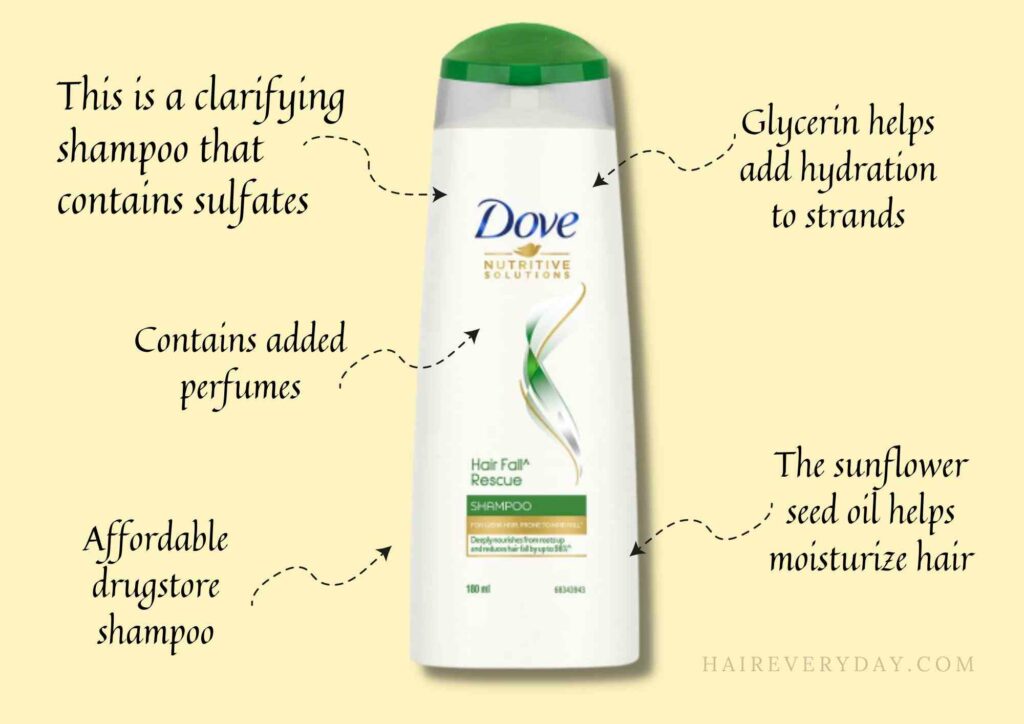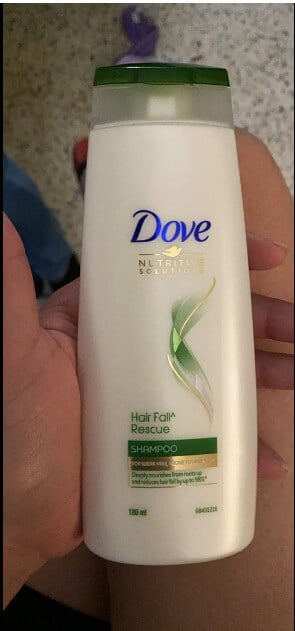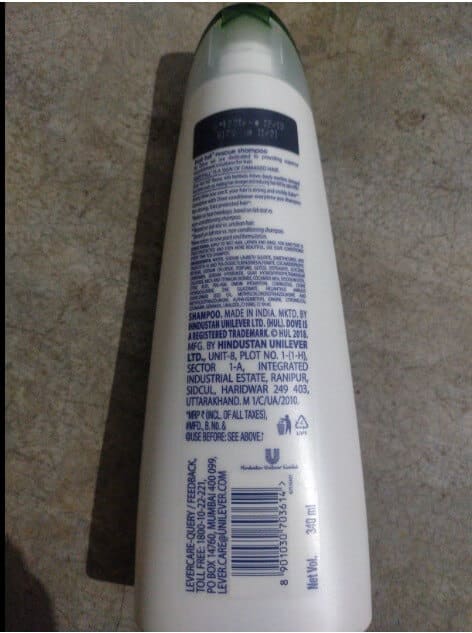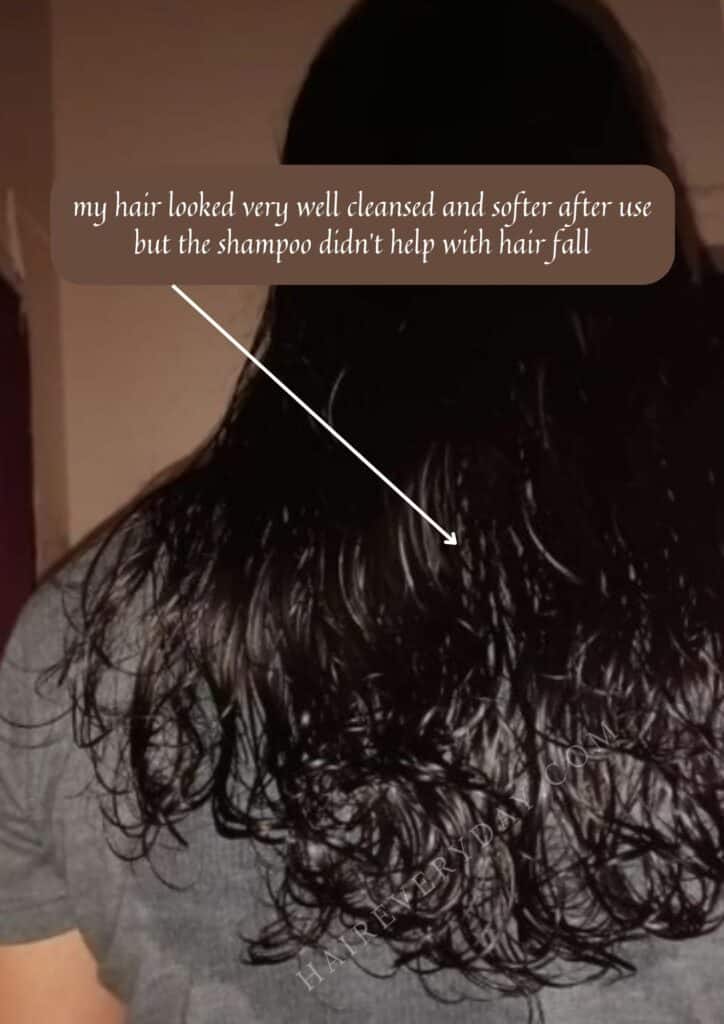Here's the Dove Hair Fall Rescue Shampoo review where I have explained the shampoo side effects, benefits, ingredients, formula and more.
It is very difficult these days to get hair products that are both affordable and effective. So when I was trying to find a good drugstore shampoo I came across this Dove Hair Fall Rescue Shampoo. I had a lot of breakage at the time due to using a lot of styling products and treatments on my tresses.
I used the shampoo for 4 weeks where I first used it 2-3 times a week and then reduced it to once a week when I found out how clarifying it was.
Read on below to know how this shampoo fared in reducing hair fall and if it’s worth buying!
Key Takeaways:
- Is It Sulfate Free - No (contains Sodium Laureth Sulfate)
- Top Ingredients - SLES, Glycerin, Sunflower Seed Oil
- Who It’s Suitable For - People with excessive product buildup on hair and scalp, greasy scalp
- Fragrance - Floral Scent from Artificial Perfume Source
- Is It Colored Hair-Friendly - No
- Is It Good For Sensitive Scalp - No
- Is It Preservatives-Free - No
- Price Range - $$ Affordable (180ml bottle for $12.79)
Is Dove Hair Fall Rescue Shampoo good for hair?
Dove Hair Fall Rescue Shampoo is designed to reduce hair fall and strengthen hair strands. It contains ingredients like Trichazole actives and Nutrilock actives that are intended to nourish the roots and help anchor hair firmly in place, reducing hair fall due to breakage. Many users find it effective for making their hair appear fuller and more robust. However, the suitability can vary depending on individual hair types and conditions. It's always recommended to assess your hair's specific needs and consider any sensitivities to ingredients when determining if a product is good for your hair.

Top Ingredients Explained - Dove Hair Fall Rescue Shampoo
Aqua, Sodium Laureth Sulfate, Dimethiconol, Cocamidopropyl Betaine, Sodium Chloride, Glycerin, Parfum, Sodium Benzoate, Glycol Distearate, Carbomer, Gluconolactone, Guar Hydroxypropyltrimonium Chloride, Hydroxypropyl Methylcellulose, Cocamide MEA, Tea-Dodecylbenzenesulfonate, Sodium Sulfate, Mica, Trehalose, Tea-Sulfate, PEG-45M, Lysine Hcl, Silica, Sodium Hydroxide, Citric Acid, PPG-9, Disodium EDTA, Phenoxyethanol, Hexyl Cinnamal, Limonene, Linalool, Ci 15985, Ci 19140, Ci 77891

| Ingredient Name | What It Does |
| Aqua | solvent |
| Sodium Laureth Sulfate | surfactant/cleansing, emulsifying |
| Dimethiconol | emollient, moisturizer/humectant |
| Cocamidopropyl Betaine | surfactant/cleansing, viscosity controlling |
| Sodium Chloride | viscosity controlling |
| Glycerin | skin-identical ingredient, moisturizer/humectant |
| Parfum | perfuming |
| Sodium Benzoate | preservative |
| Glycol Distearate | emollient, emulsifying, viscosity controlling |
| Carbomer | viscosity controlling |
| Gluconolactone | exfoliant, chelating |
| Guar Hydroxypropyltrimonium Chloride | viscosity controlling |
| Hydroxypropyl Methylcellulose | surfactant/cleansing, viscosity controlling |
| Cocamide MEA | surfactant/cleansing, viscosity controlling, emulsifying |
| Tea-Dodecylbenzenesulfonate | surfactant/cleansing |
| Sodium Sulfate | viscosity controlling |
| Mica | colorant |
| Trehalose | moisturizer/humectant |
| Tea-Sulfate | buffering |
| PEG-45M | moisturizer/humectant |
| Lysine Hcl | |
| Silica | viscosity controlling |
| Sodium Hydroxide | buffering |
| Citric Acid | buffering |
| PPG-9 | |
| Disodium EDTA | chelating |
| Phenoxyethanol | preservative |
| Hexyl Cinnamal | perfuming |
| Limonene | perfuming, solvent |
| Linalool | perfuming |
| Ci 15985 | colorant |
| Ci 19140 | colorant |
| Ci 77891 | colorant |
Sodium Laureth Sulfate
I know, I know. The shampoo contains sulfates. But as far as surfactants go, Sodium Laureth Sulfate (SLES) is slightly milder and less irritating than Sodium Lauryl Sulfate (SLS).
Okay so think of this way, SLS is the worst offending surfactant which can lead to redness, dryness, irritation, etc. on skin. SLES isn’t as bad but it can trigger irritation if you have sensitive scalps, Ammonium lauryl sulfate is generally safer and mild.
While most coconut-derived surfactants like cocamide MEA, etc. are known to be safe on sensitive skin as well.
So SLES is fantastic for cleaning your scalp of debris, dirt, excess oil and product buildup, but it can strip hair dye so it shouldn’t be used on color-treated hair.
If you’re wondering why this was included in a hair fall control shampoo, here’s the logic behind it.
Sometimes, hair fall can be because your hair root is weakened due to dandruff, buildup, etc. This buildup prevents nutrients from reaching your hair follicles and also stops hair products like oils, serums, etc. to reach the root.
So a strong surfactant can clarify your scalp, clearing the way for hair fall medication like serums, etc. to reach your follicles and help them get adequate nutrition.
Dimethiconol
Dimethiconol is a conditioning agent that is a part of the silicone family. Yes, this shampoo contains silicones too! No silicones are not all bad.
Dimethiconol is an occlusive, which means it coats the fibers of your hair and scalp skin, preventing water loss by evaporation. Now this is great to keep hair hydrated but in the long run, dimethiconol can clog pores on your scalp.
It is also not water soluble so it can coat your hair strands, weighing your tresses down.

Sunflower Seed Oil
Sunflower seed oil is an excellent ingredient to have in hair products, including shampoos. First of all it’s rich in Vitamin E, which helps smoothen hair and add softness and shine.
This oil is also very light and non-greasy so your hair won’t feel weighed down after you use this shampoo.
Sunflower seed oil is also rich in antioxidants, anti-inflammatory ingredients and nutrients such as linoleic acid, calcium, niacin and iron. All of these help fortify the hair cortex, prevent breakage and increase hair strength.
Glycerin
I love to see glycerin in shampoos. Most shampoos contain only moisturizing ingredients and not humectants. What’s the difference you ask?
Well, moisturizing ingredients like most oils only lock in the moisture, smoothing your hair.
But humectants like glycerin attract moisture to your strands, hydrating them and then preventing the moisture from escaping. This makes glycerin an excellent ingredient to use on low porosity hair, dehydrated hair, damaged hair, etc.
Hydrated hair is generally more elastic and less prone to breakage, hence glycerin helps reduce hair fall this way.
DMDM Hydantoin
Dove Shampoos has received a lot of flak in recent years as a lot of its shampoo lines still contained DMDM Hydantoin as an ingredient.
This ingredient is a common preservative used in shampoos because of its fantastic antimicrobial and antibacterial properties. It prevents yeast, fungi, bacteria, etc. from growing in shampoos, especially considering most products are placed in a warm, moist environment in your showers.
However, recent studies have shown that DMDM Hydantoin releases formaldehyde which is known to cause severe allergic reactions. (N. Latorre, J.F. Silvestre, A.F. Monteagudo, Allergic Contact Dermatitis Caused by Formaldehyde and Formaldehyde Releasers, Actas Dermo-Sifiliográficas (English Edition), Volume 102, Issue 2, 2011, Pages 86-97, ISSN 1578-2190)
It can even lead, to cancer according to the American Cancer Society.
A lot of shampoo and cosmetic brands have recalled products that contain DMDM Hydantoin but Dove hasn’t.
And now they are technically not the bad guys for doing so. This preservative is only harmful if its quantity exceeds 0.074 percent which according to the manufacturers, this shampoo doesn’t.
What I Liked About This Dove Shampoo
Let me start off by saying that this is a clarifying shampoo. I really do not suggest you use it everyday. But if you’re using it once a week or a fortnight, it can really help your hair.
I made the mistake of using it too many times a week and my hair started falling out more, until I had the sense to use it as a clarifying shampoo. My tresses then started looking better.
I liked the consistency of this shampoo. You do not need much product to get a rich lather. A little bit of the liquid and you’re done. And it also spreads through hair easily.
Which makes this shampoo one of the most affordable and pocket friendly products I’ve used on my hair.
I often use a lot of gels, creams, etc. on my hair (which has a straight texture) and this shampoo helped remove a lot of the buildup, adding volume back to my tresses. So that was a plus.
The shampoo also works very well if you have a very oily scalp and dry, frizzy tresses as it clarifies scalp and the sunflower oil formula nourishes hair.

What I Disliked About This Dove Shampoo
The shampoo is a bit too harsh, that’s my main complaint about it. I don’t think price is a factor as there are sulfate-free drugstore shampoos from brands like Tresemme and OGX. So I don’t like the choice Dove had made to add SLES to this shampoo. It makes it unsuitable for color-treated hair.
I also didn’t like that they are still using DMDM hydantoin as a preservative, especially with all the uproar surrounding this ingredient. However, the brand has said that the preservative is within safe limits.
Now coming to the fragrances. I do like the scent in this one, it smells very fresh and gardeny. But it’s all from artificial perfume sources. My scalp handles it just fine, but I believe it can trigger reactions in people with sensitive skin, perfume allergies or conditions like eczema or psoriasis.
Possible Side Effects of Dove Shampoo
As with any hair care product, individual reactions may vary, and some people may experience side effects while using Dove Hair Fall Rescue Shampoo. It's important to note that the majority of users do not encounter adverse reactions and find the product safe and effective. However, here are some potential side effects to be aware of:
- Scalp Irritation: Some users may experience mild scalp irritation, itching, or redness. This could be due to sensitivity to certain ingredients in the shampoo.
- Allergic Reactions: In rare cases, individuals may have allergic reactions to certain components in the shampoo, leading to symptoms like hives, rash, or swelling. If you notice any allergic reaction, discontinue use immediately and seek medical advice.
- Dryness or Over-Cleansing: Shampoos formulated to address hair fall concerns may contain ingredients that can be slightly drying to the hair or scalp, especially if used too frequently or in excess.
- Incompatibility with Hair Type: Not all hair types are the same, and some individuals may find that the Dove Hair Fall Rescue Shampoo does not suit their specific hair needs, leading to issues like excessive dryness or oiliness.
- Hair Texture Changes: Some users may notice changes in their hair texture, such as increased frizz or loss of natural shine, though these effects are not common.
- Sulfates: There is Sodium Laureth Sulfate in the shampoo formula, while this is a great cleanser, the ingredient can help reduce
FAQs about the Dove Hair Fall Rescue Shampoo
Is Dove Hair Fall Rescue good for hair fall?
Can I use Dove Hair Fall Rescue Shampoo daily?
Which Dove shampoo is sulphate free?
Who owns Dove shampoo?
Summary on the Dove Hair Fall Rescue Shampoo
So this Dove Hair Fall Rescue shampoo didn’t stand up to my expectations at all. I didn’t like that a shampoo that is marketed as being a hair fall control shampoo has sulfates in it.
I also didn’t like that the shampoo contained synthetic perfumes, preservatives that are known to be harmful and added colorants as well.
It will absolutely not work well on sensitive scalps or people with color-treated hair.
This Dove is pretty affordable (I got a 180ml bottle for $12.79 online) however there are shampoos like the Tresemme Scalp Care shampoo which is free from DMDM Hydantoin and the OGX Thick and Full Shampoo which is sulfate free at similar prices.
So I’d suggest you go for these instead.
I guess the Dove Hair Fall Rescue shampoo can be used as a clarifying shampoo. However it’s definitely not for daily use.
Also Read:
Nécessaire The Shampoo Ingredients + Review 2025
Acure Ultra Hydrating Shampoo Ingredients + Review 2025
Aluram Moisturizing Shampoo Ingredients + Review 2025

